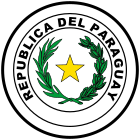 |
|---|
The Republic of Paraguay is governed under the constitution of 1992, which is the country's sixth since independence from Spain in 1811.
 |
|---|
The Republic of Paraguay is governed under the constitution of 1992, which is the country's sixth since independence from Spain in 1811.
The recorded history of Paraguay began in 1516 with the failed expedition of Juan Díaz de Solís to the Río de la Plata estuary, which divides Argentina and Uruguay. After further voyages of conquest, Paraguay became another of Spain's South American colonies. Paraguay finally gained its independence from Spain in 1811.
The Constitutional Governmental Regulations, approved by the Congress of Paraguay two years after its independence from Spain in October 1813. The Constitutional Governmental Regulations contained seventeen articles, providing for a government by headed by two consuls, José Gaspar Rodríguez de Francia and Fulgencio Yegros. The framers also provided for a legislature of 1,000 representatives. Recognizing the importance of the military in the embattled country, the framers gave each consul the rank of brigadier general and divided the armed forces and arsenals equally between them. However within ten years of adoption the Constitutional Governmental Regulations, both Consul Yegros and the Paraguayan legislature had been eliminated and Francia ruled directly until his death in 1840. [1]
In 1841 Francia's successor, Carlos Antonio López, asked the legislature to revise the Constitutional Governmental Regulations. Three years later, a new constitution granted López powers as broad as those Francia had used to govern. Congress could make and interpret the laws, but only the President could order that they be promulgated and enforced. The constitution placed no restrictions on the powers of the president, beyond limiting his term of office to ten years. There was no mention of the word liberty in the entire text. Congress subsequently made López president for life. He died in 1862 after 22 years of rule. [1] [2] His son, Francisco Solano López, ruled under this constitution as well.
At the end of the disastrous Paraguayan War (1865 - 1870), a Constituent assembly adopted a new constitution in November 1870, which, with amendments, remained in force for seventy years. The constitution was based on principles of popular sovereignty, separation of powers, and a bicameral legislature consisting of a Senate and a Chamber of Representatives. Although its tenor was more democratic than the two previous constitutions, extensive power over the government and society in general remained in the hands of the President. [1]
On February 18, 1940 President José Felix Estigarribia responded to a political stalemate by dissolving Congress and assuming emergency powers. To dramatize his government's desire for change, he scrapped the 1870 constitution and promulgated a new one on July 10, 1940. It was based on the 1937 Brazilian constitution which had established the Estado Novo regime. The new constitution was a severely authoritarian document that reflected Estigarribia's concern for stability and power. It provided for an extremely powerful state, with sweeping powers vested in the executive. The president now was chosen in direct elections for a term of five years, and was eligible for a second term. He could intervene in the economy, control the press, suppress private groups, suspend individual liberties, and take exceptional actions for the good of the state. He also had the power to declare a state of siege, which allowed him to suspend civil liberties in either the entire country or a portion of it for 90 days. The Senate was abolished and a unicameral Chamber of Representatives reduced in power. A new advisory Council of State was created, modeled on the experience of corporatist Italy and Portugal, to represent group interests including business, farmers, bankers, the military, and the Roman Catholic Church. The military was entrusted with responsibility to safeguard the Constitution. [1] On August 4, 1940 a referendum approved this constitution.
After taking power in 1954, President Alfredo Stroessner governed for the next thirteen years under the constitution of 1940. A Constituent Assembly elected in 1967 drafted a new constitution that went into force later that year. It maintained the overall authoritarian character of the 1940 document, including the broad powers vested in the president. Nevertheless, it reinstated the Senate and renamed the lower house the Chamber of Deputies. In addition, the assembly allowed the president to be reelected for another two terms beginning in 1968. [1]
The constitution of 1967 contained a preamble, eleven chapters with 231 articles, and a final chapter of transitory provisions. The first chapter contains eleven "fundamental statements" defining a wide variety of topics, including the political system (a unitary republic with a representative democratic government), the official languages (Spanish and Guaraní), and the official religion of Roman Catholicism. The next two chapters dealt with territory, civil divisions, nationality, and citizenship. Chapter four contained a number of general provisions, such as statements prohibiting the use of dictatorial powers, requiring public officials to act in accordance with the constitution, and entrusted national defense and public order to the armed forces and police, respectively. [1]
Chapter five, with seventy-nine articles, was by far the longest section of the constitution, and deals in considerable detail with the rights of the population. This chapter purportedly guaranteed the population extensive liberty and freedom before the law without discrimination. In addition to the comprehensive individual rights, spelled out in thirty-three articles, there are sections covering social, economic, labor, and political rights. For example, Article 111 stipulates that "The suffrage is the right, duty, and public function of the voter... Its exercise will be obligatory within the limits to be established by law, and nobody could advocate or recommend electoral abstention." The formation of political parties was also guaranteed, although parties advocating the destruction of the republican regime or the multiparty representative democratic system are not permitted. This chapter also specified five obligations of citizens, including obedience to the constitution and laws, defense of the country, and employment in legal activities. [1]
In practice, however, these rights were largely ignored, as Stroessner ruled under a state of siege for only a few short breaks from 1954 to 1987. This power, carried over from the 1940 constitution, allowed the president to suspend constitutional freedoms for up to 90 days in either all or part of the country. Within five days of declaring a state of siege, the president was required to notify Congress of his reasons for doing so, the rights being restricted, and the portion(s) of the country where it applied. Stroessner had declared a state of siege soon after taking office, and had it renewed every 90 days. Although the state of siege technically only applied to Asunción after 1970, the courts held that anyone charged with security offenses could be brought to the capital and tried under the state-of-siege provisions—even if the offense occurred elsewhere. [3]
Chapter six identified agrarian reform as one of the fundamental factors for the achievement of rural well-being. It also called for the adoption of equitable systems of land distribution and ownership. Colonization was protected as an official program involving not only citizens but also foreigners. [1]
Chapters seven through ten concerned the composition, selection, and functions of the legislature, executive, judiciary, and attorney general, respectively. Chapter eleven discussed provisions for amending or rewriting the constitution. The final chapter contained transitory articles. The most important of these stated that, for purposes of eligibility and re-eligibility of the president, only those terms that would be completed after the presidential term that expired on August 15, 1968 counted. The only constitutional amendment, that of March 25, 1977, modified this article to allow the president to run for an unlimited number of five-year terms. [1]
| | This section needs expansion. You can help by adding to it. (August 2009) |
Stroessner was overthrown in a 1989 coup led by one of his longtime confidants, Andrés Rodríguez. Per the provisions of the 1967 Constitution, Rodríguez assumed power as interim president and was elected later that year to serve the balance of Stroessner's eighth term. The constitution required new elections if a president dies or resigns less than two years into a term, and only then for the balance of the term.
Rodriguez governed for three years under the 1967 Constitution. That document was replaced with a much more democratic constitution in 1992. It provides for a division of government powers among three branches. [4]
While the presidency remained the key institution, its powers were significantly reduced in response to the abuses of the past. The president is limited to a single five-year term. [5] He also lost the power to appoint and dismiss judges and dissolve the legislature at will, and also lost his previous control over government spending. [6]
The constitution also instituted the first meaningful system of checks and balances the country had ever seen. For instance, Congress acquired the power to impeach and remove the president and state ministers; there had been no such provision in the 1967 constitution.
The ban on any sort of presidential reelection has become so entrenched that protests ensued in 2017 when the legislature deliberated an amendment that would have allowed a president to run for a second five-year term, even if it is nonconsecutive. Had it passed, it would have cleared the way for incumbent Horacio Cartes to run for reelection the following year. The Constitution establishes that any modifications to a president's term should occur via a reform and not an amendment. Cartes ultimately gave up any plans to run again, and the amendment was defeated.
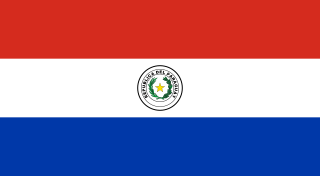
Paraguay, officially the Republic of Paraguay, is a landlocked country in South America. It is bordered by Argentina to the south and southwest, Brazil to the east and northeast, and Bolivia to the northwest. It has a population of around 6.1 million, nearly 2.3 million of whom live in the capital and largest city of Asunción, and its surrounding metro area.
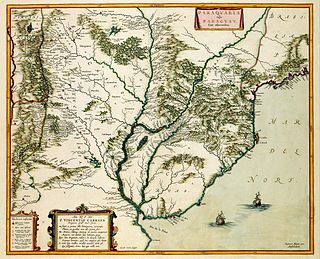
The history of Paraguay encompasses thousands of years of human habitation. Both agricultural and nomadic Guaycuruan lived in the region at the time of the Spanish Conquest. It became a relatively neglected part of the Spanish Empire due to its isolation and lack of mineral wealth, nonetheless a small group of Spanish settlers came to reside in the area, increasingly intermarrying with native women to produce a mestizo population. In the 17th and 18th centuries, Jesuit missionaries organized the natives into planned communities known as reducciones, and the experiment gained notable attention in Enlightenment Era Europe.

Alfredo Stroessner Matiauda was a Paraguayan army officer, politician and statesman who served as President of Paraguay from 15 August 1954 to 3 February 1989. Stroessner led a coup d'état on 4 May 1954 with the support of the army and the Colorado Party, with which he was affiliated. After a brief provisional government headed by Tomás Romero Pereira, he was the Colorado Party's presidential candidate for the 1954 general election, and was elected unopposed since all other parties were banned from 1947 to 1962.

Andrés Rodríguez Pedotti was a military officer and politician, being President of Paraguay from February 3, 1989, to August 15, 1993. He led the coup d'état on February 2 and 3, 1989, against the dictator Alfredo Stroessner Matiauda.
A constitutional amendment is a modification of the constitution of a polity, organization or other type of entity. Amendments are often interwoven into the relevant sections of an existing constitution, directly altering the text. Conversely, they can be appended to the constitution as supplemental additions, thus changing the frame of government without altering the existing text of the document.

The Spanish Constitution is the supreme law of the Kingdom of Spain. It was enacted after its approval in a constitutional referendum; it represents the culmination of the Spanish transition to democracy. It is a written constitution.

The Constitution of South Africa is the supreme law of the Republic of South Africa. It provides the legal foundation for the existence of the republic, it sets out the rights and duties of its citizens, and defines the structure of the Government. The current constitution, the country's fifth, was drawn up by the Parliament elected in 1994 in the South African general election, 1994. It was promulgated by President Nelson Mandela on 18 December 1996 and came into effect on 4 February 1997, replacing the Interim Constitution of 1993. The first constitution was enacted by the South Africa Act 1909, the longest-lasting to date. Since 1961, the constitutions have promulgated a republican form of government.
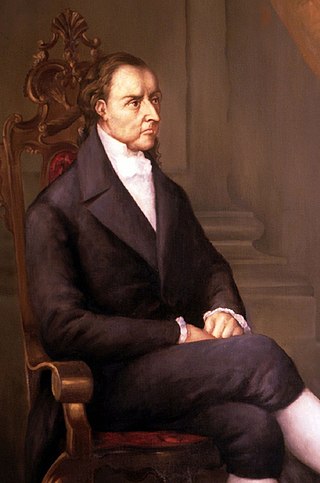
José Gaspar Rodríguez de Francia y Velasco was a Paraguayan lawyer and politician, and the first dictator (1814–1840) of Paraguay following its 1811 independence from the Spanish Viceroyalty of the Río de la Plata. His official title was "Supreme and Perpetual Dictator of Paraguay", but he was popularly known as El Supremo.
A supermajority is a requirement for a proposal to gain a specified level of support which is greater than the threshold of more than one-half used for a simple majority. Supermajority rules in a democracy can help to prevent a majority from eroding fundamental rights of a minority, but they can also hamper efforts to respond to problems and encourage corrupt compromises at times when action is taken. Changes to constitutions, especially those with entrenched clauses, commonly require supermajority support in a legislature. Parliamentary procedure requires that any action of a deliberative assembly that may alter the rights of a minority have a supermajority requirement, such as a two-thirds vote. In consensus democracy the supermajority rule is applied in most cases.
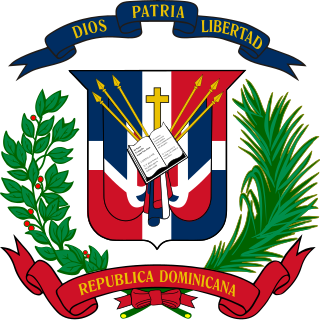
The Congress of the Dominican Republic is the bicameral legislature of the government of the Dominican Republic, consisting of two houses, the Senate and the Chamber of Deputies. Both senators and deputies are chosen through direct election. There are no term limits for either chamber.

Carlos Antonio López Ynsfrán was leader of Paraguay from 1841 to 1862.
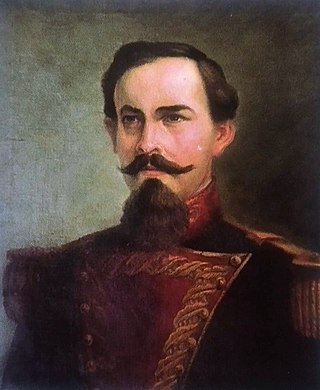
Fulgencio Yegros y Franco de Torres was Paraguayan soldier and first head of state of independent Paraguay. The town of Yegros is named in his honor.
The Constitution of the Philippines is the constitution or the supreme law of the Republic of the Philippines. Its final draft was completed by the Constitutional Commission on October 12, 1986, and ratified by a nationwide plebiscite on February 2, 1987.
The Constitutional history of the People's Republic of China describes the evolution of its Constitutional system. The first Constitution of the People's Republic of China was promulgated in 1954. After two intervening versions enacted in 1975 and 1978, the current Constitution was promulgated in 1982. There were significant differences between each of these versions, and the 1982 Constitution has subsequently been amended several times. In addition, changing Constitutional conventions have led to significant changes in the structure of the Chinese government in the absence of changes in the text of the Constitution.
Below is the timeline of Paraguayan history.
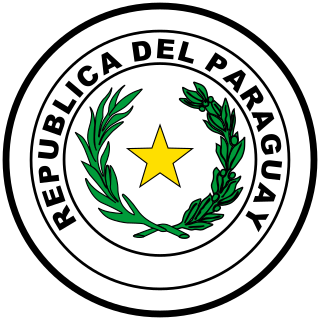
Constitutional Assembly elections were held in Paraguay on 7 May 1967. The Colorado Party won 80 of the 120 seats. Voter turnout was 68.9%. Following the election, the country's fifth constitution was promulgated in August.

The dictatorship of Alfredo Stroessner, colloquially known as Stronismo or Stronato; was the period of almost 35 years in the history of Paraguay in which army general Alfredo Stroessner ruled the country as a de facto one-party state under an authoritarian military dictatorship, from 15 August 1954 to 3 February 1989.

Carmen Casco de Lara Castro was a Paraguayan teacher, women's and human rights advocate, and politician. She established one of the first independent human rights organizations in Latin America and fought for both women's equality and an end to state-sponsored terrorism under the dictatorship of Alfredo Stroessner. She was influential in passing legislation for pay equity and maternity rights, as well as securing the repeal of laws curtailing basic human rights.

The 1989 Paraguayan coup d'état, also known as La Noche de la Candelaria, was a coup d'état that took place on 2–3 February 1989 in Asunción, Paraguay, led by General Andrés Rodríguez against the regime of long-time leader Alfredo Stroessner. The bloody overthrow which saw numerous soldiers killed in street fighting was sparked by a power struggle in the highest echelons of the government. Rodríguez's takeover spelled the end of El Stronato, Stroessner's thirty-four year long rule, at the time the longest in Latin America, and led to an array of reforms which abolished numerous draconian laws and led to the liberalization of Paraguay.